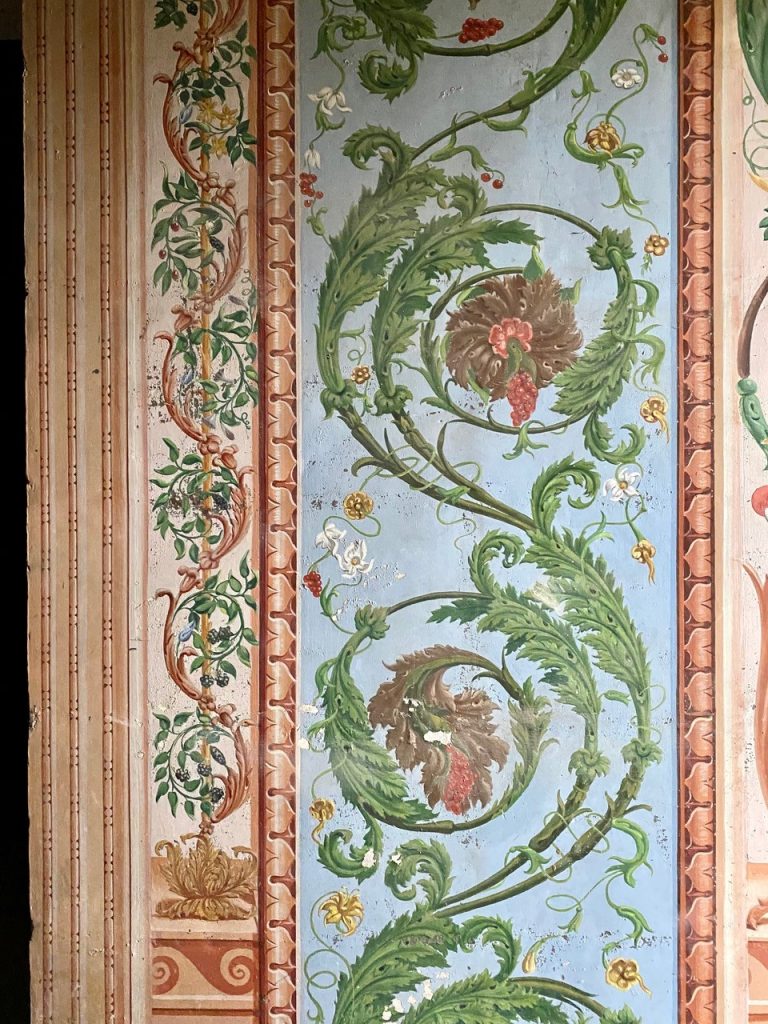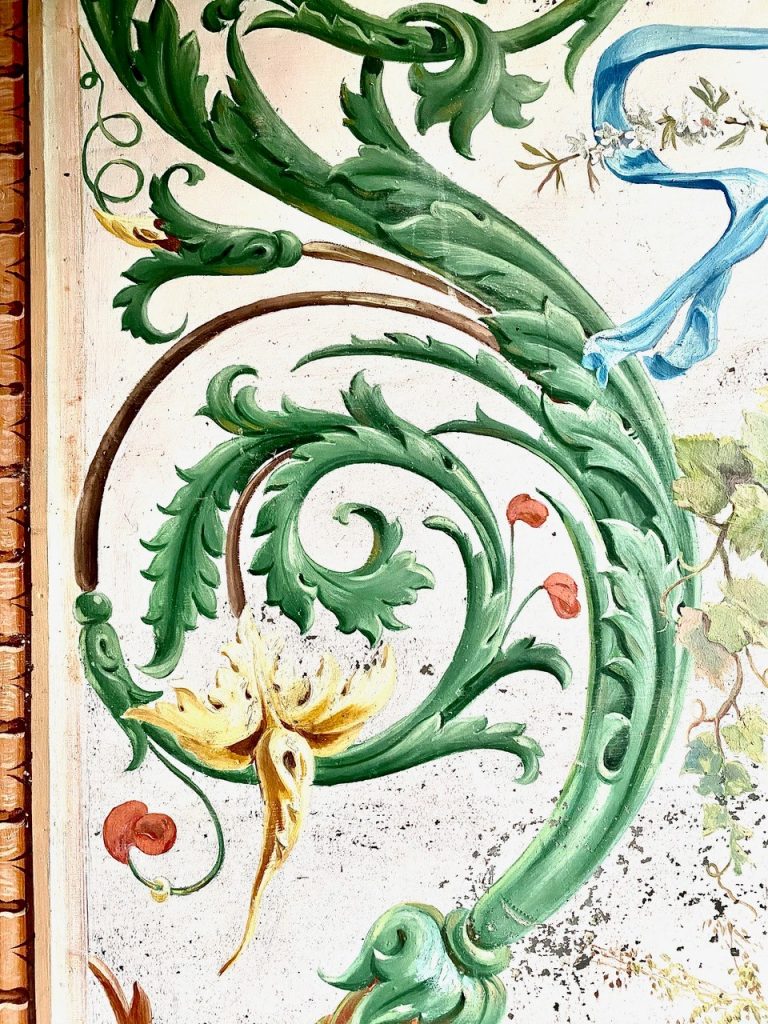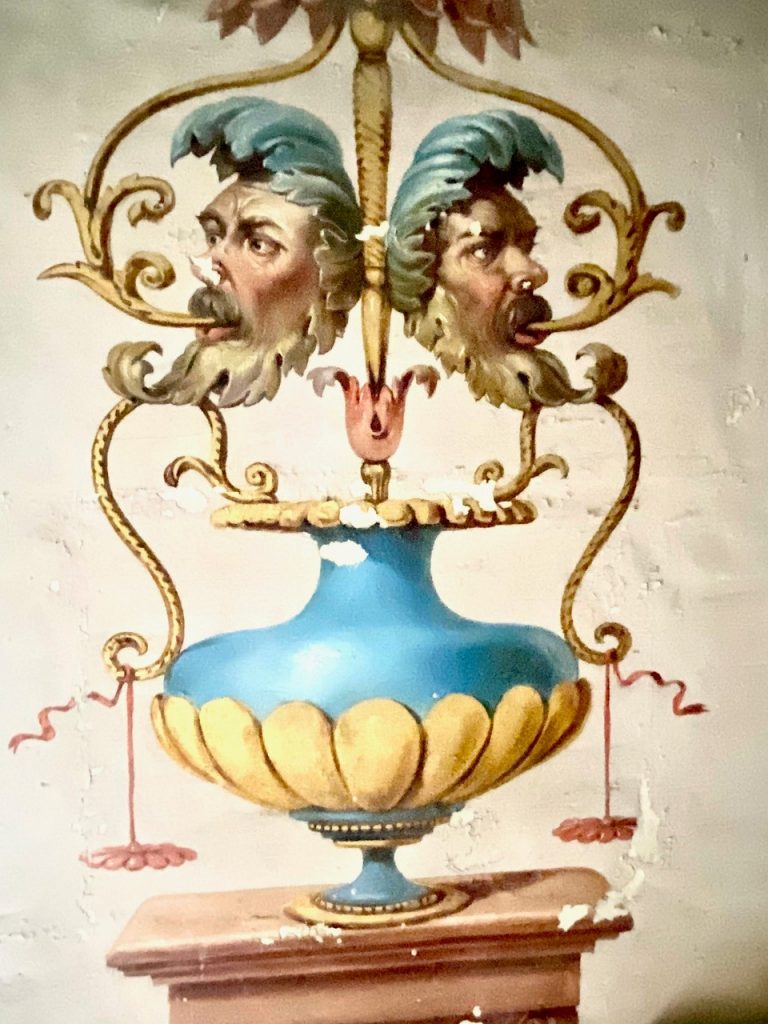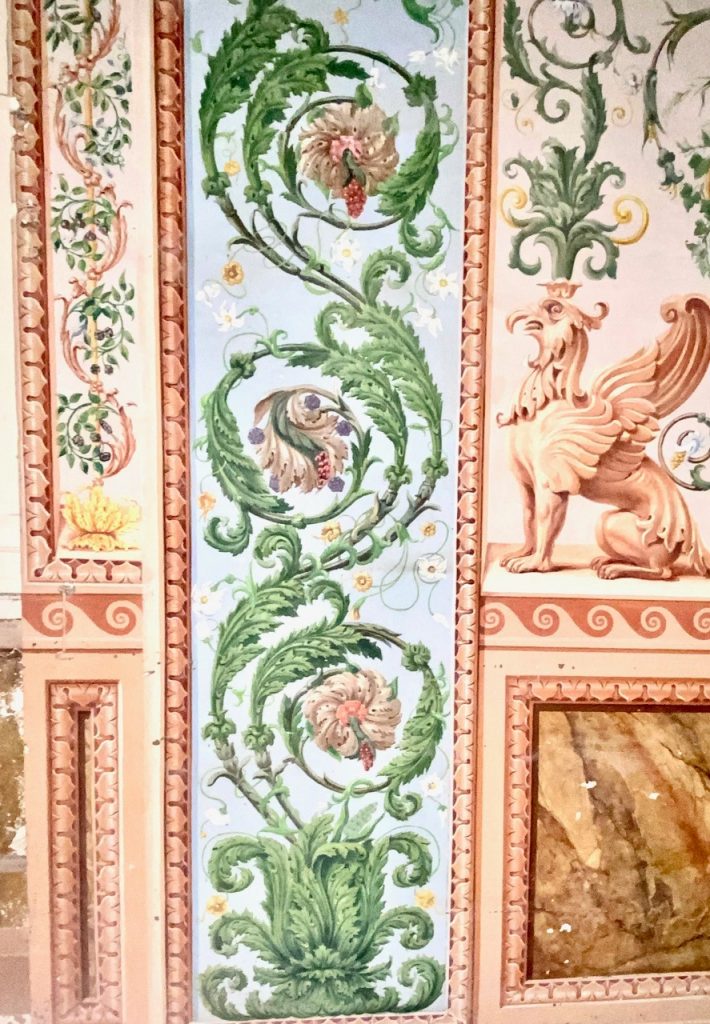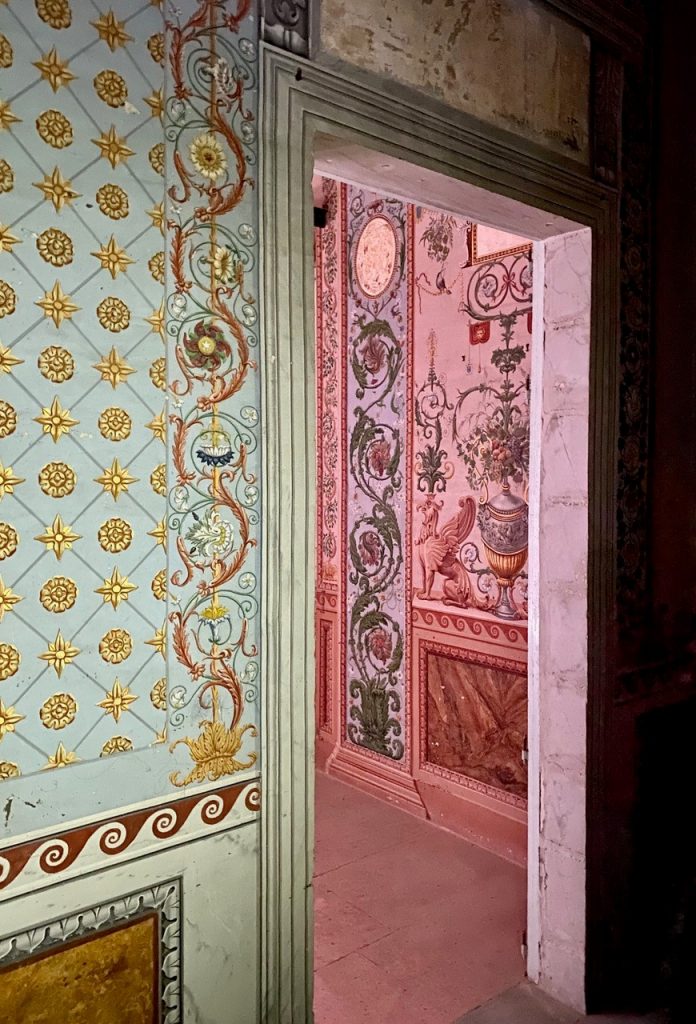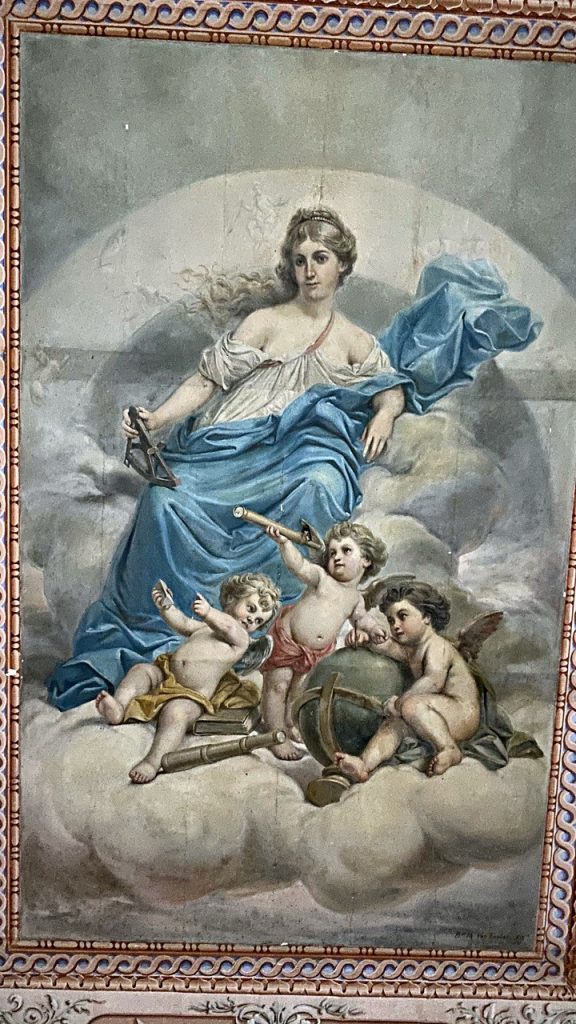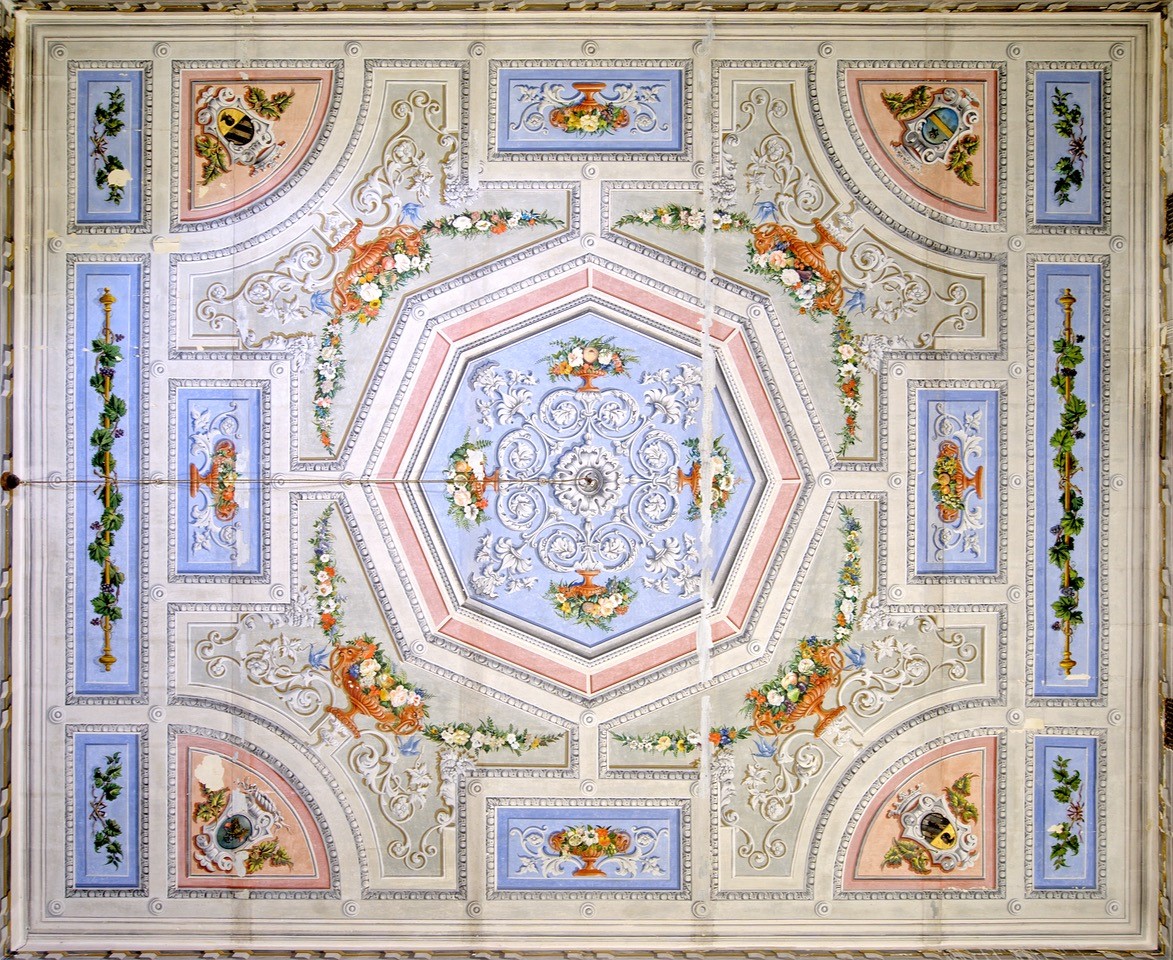
15 Dec Polychromes
During the preliminary analysis of the Villa’s potential, we closely examined rooms adorned with murals. The best-preserved frescoes are situated on the first floor of the Villa. Here, one can distinguish three rooms, each with a distinct theme.
The main room, dubbed the “Room of Abundance and Passion”, illustrates the four seasons depicted in floral patterns. This joyful reflection of the solar cycle is complemented by scenes decorating the ceiling, depicting Baron Tucher’s passions, such as music, hunting, travels, and astronomy.
The second room, symbolising crops, fertility, and abundance, is known as the “Ladies’ Room”. Here, decorative wreaths of fruit form garlands, cascading from the ceiling to the floor.
The third room, distinguished in its graphics and labelled the “Gentlemen’s Room”, is ornamented with stars and fleur-de-lis, representing the insignia of nobility. The ceiling is crowned by a depiction of Baron von Tucher, amidst grinning devilish faces representing the four cardinal points.
The decoration of these three rooms is the work of Giuseppe Calì. Born on 14th August 1846, in Valletta, in a Neapolitan family settled in Malta, Calì demonstrated his talent and interest in painting from an early age. He completed his studies at the renowned Accademia delle Belle Arti in Naples, under the watchful eye of another famous Italian painter, Professor Giuseppe Manchinelli (1813-1875), who was himself a pupil of Vincenzo Camuccini (1771-1844).
Cali, acknowledged for his industriousness, original creative inventiveness, and artistic fertility, earned the artistic nickname “the devil with a brush”. Throughout his fruitful creative life, he produced over 600 works, most of which have gone down in Maltese painting history. Calì is considered the founder of the so-called “Maltese School of Painting”.
Cali’s works are not only meticulous in their painterly details, indicating a high level of painting technique, but they also reveal his versatility, uniqueness, and artistic courage. In his works, Cali didn’t rigidly adhere to the rules of style but deliberately broke them, mixing styles. This demonstrates his talent and masterful painting technique, focused on faithfully representing reality, understanding human anatomy, and theatrical framing that conveys gravity and dynamism.
An analysis of the ornamentation suggests that Cali drew from the French, German, and Italian Renaissance, which formed his “ornamental base”. This is evidenced by the arabesques and grotesques dominating the villa’s frescoes.
The Grotesque is an ancient plant ornament comprising a plant tendril inseparably interwoven with other elements, such as human figures, animals, parts of armour, images, fruits, and others. The Arabesque, frequently employed by Calì, is an ornament originating from ancient Greek and Roman art. It is a stylised plant tendril, often accompanied by additional elements like parts of armour, fruits, and human figures. Arabesques were primarily used to embellish separate pilasters and architectural features.
The aforementioned “ornamental base” was individually enriched by Calì with separate elements of 17th-19th-century ornamentation. The “Franco-German” direction of the ornamentation is suggested by the distinctive patterns of arabesques and grotesques found in residences throughout France and Germany from the Renaissance period. The Italian direction is indicated by patterns derived from Vatican ornamentation.
The ornamentation analysis suggests that Calì found inspiration in the frescoes and motifs of the Salon of Laurent Girmond de la Reyniere’s apartment on Rue Boissy d’Anglas in Paris, the interiors of the courtyard of the town hall in Florence (Palazzo Vecchio Firenze) painted by Michelangelo Buonarroti, and the Arcades of the Apostolic Palace painted by Raphael Santi. The art techniques of etching and engraving contributed to the quick dissemination of copied or newly invented grotesque patterns and were used to portray motifs on wall paintings.
Two captivating fragments of the murals intrigued us. The first, a Baroque scene with cherubs, features a young woman who is likely Maria Victoria, the wife of the Baron, as indicated by the initials in the lower part of the fresco. The composition, combined with astrological motifs displayed through zodiac signs in the background, refers to the Baron’s interests. The painting is surrounded by an elaborate ceiling imitating coffering. The decorative walls of this interior emphasise the wealth of colours and decorations.
The second intriguing fragment is an inscription on the wall opposite the fireplace.
“SINCERE ET CONSTANTER”, translating from Latin to “HONEST AND STEADY”, and from Italian to “SINCERE AND STEADY”.
Both translations point to deeply rooted principles and character traits of the Baron.
Baroque scenes with cherubs, combined with floral motifs, form a composition also found on the ceiling of the bedroom on the second floor. The absence of other decorations on the walls is intriguing, given the rather ornate motif presented.
Equally attention-grabbing alongside the frescoes is the neo-renaissance fireplace in the main living room. Inspired by the French renaissance, it features an open hearth.
The examination of numerous damages and peeling of paint layers necessitated an urgent step, namely, the appointment of a specialist in the field of Calì’s painting, as well as an expert in the specifics of Maltese polychrome.
The most recommended expert from many quarters was Pierre Bugeja from PrevArti, a highly respected workshop. When he first arrived at the Villa, like us, he reacted to the wonder of the magnificent murals. He enthusiastically undertook the process of safeguarding and conserving these artworks.
We will be reporting on the further progress of work on the murals.


